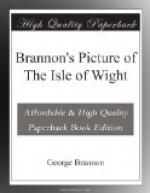And after all, the Doctor’s objection to a residence in town, is largely compensated for in the case of Ventnor, by the many advantages afforded to invalids, that could be procured only in a populous place: such for instance as regular stage-coaches running to and from Ryde and other places; a good landing-place; bathing-machines; a post-office and reading-rooms; the location of several apothecaries and eminent physicians: tradesmen of almost every description; and the facility of enjoying society in the dullest winter months.
Westward of Ventnor, we have a sudden and most agreeable transition from the glare of the town to a quiet picture of rural scenery, broken only by two or three cottages neatly built in the antique style; this is the commencement of the property of Mr. Hambrough (of Steephill Castle), which extends to St. Lawrence, the estate of Earl Yarborough; succeeded by Old Park; and near Niton, the seats of Mrs. Arnold, Sir W. Gordon, and Mrs. Vine: altogether a delightful distance of above four miles; which we hope will long escape any desecration of its beauties by the operations of building speculators.
* * * * *
APPULDURCOMBE.
This splendid seat, from its proximity to the Undercliff, is most frequently embraced either in the south-eastern or the continued Tour, in preference to giving it a separate day: therefore here is perhaps the best place for its notice, especially as the regular road from Ventnor to Newport passes close by: and as it is only two miles from the former town. It is thus described by Sir Richard Worsley, in his “History of the Isle of Wight:”




